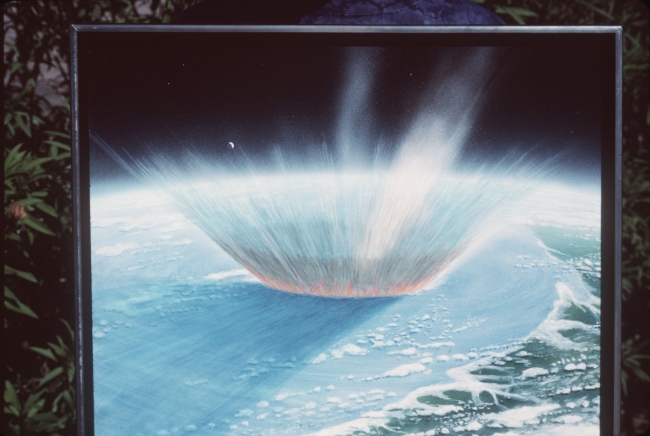PARIS (AFP) ― The space rock that smashed into Earth 65 million years ago, famously wiping out the dinosaurs, unleashed acid rain that turned the ocean surface into a witches’ brew, researchers said Sunday.
Delving into the riddle of Earth’s last mass extinction, Japanese scientists said the impact instantly vaporized sulphur-rich rock, creating a vast cloud of sulphur trioxide gas.
This mixed with water vapor to create sulphuric acid rain, which would have fallen to the planet’s surface within days, acidifying the surface levels of the ocean and killing life therein.
Those species that were able to survive beneath this lethal layer eventually inherited the seas, according to the study which did not delve into the effects on land animals.
“Concentrated sulphuric acid rains and intense ocean acidification by impact vapors resulted in severe damage to the global ecosystem and were probably responsible for the extinction of many species,” the study said.
Delving into the riddle of Earth’s last mass extinction, Japanese scientists said the impact instantly vaporized sulphur-rich rock, creating a vast cloud of sulphur trioxide gas.
This mixed with water vapor to create sulphuric acid rain, which would have fallen to the planet’s surface within days, acidifying the surface levels of the ocean and killing life therein.
Those species that were able to survive beneath this lethal layer eventually inherited the seas, according to the study which did not delve into the effects on land animals.
“Concentrated sulphuric acid rains and intense ocean acidification by impact vapors resulted in severe damage to the global ecosystem and were probably responsible for the extinction of many species,” the study said.

The great smashup is known as the Cretaceous-Tertiary extinction.
It occurred when an object, believed to be an asteroid some 10 kilometers wide, whacked into the Yucatan Peninsula in modern-day Mexico.
It left a crater 180 kilometers wide, ignited a firestorm and kicked up a storm of dust that was driven around the world on high winds, according to the mainstream scenario.
Between 60 and 80 percent of species on Earth were wiped out, according to fossil surveys.
Large species suffered especially: dinosaurs which had roamed the land for some 165 million years, were replaced as the terrestrial kings by mammals.
Much speculation has been devoted to precisely how the mass die-out happened.
A common theory is that a “nuclear winter” occurred ― the dust pall prevented sunlight reaching the surface, causing vegetation to shrivel and die, and dooming the species that depended on them.
Another fiercely debated idea adds acid rain to the mix.
Critics say the collision was far likelier to have released sulphur dioxide.
And, they argue, it would have lingered in the stratosphere rather than fallen back to Earth.
Seeking answers, a team led by Sohsuke Ohno of the Planetary Exploration Research Center in Chiba set up a special lab rig to replicate ― on a tiny scale ― what happened that fateful day.
-
Articles by Korea Herald








![[Graphic News] More Koreans say they plan long-distance trips this year](http://res.heraldm.com/phpwas/restmb_idxmake.php?idx=644&simg=/content/image/2024/04/17/20240417050828_0.gif&u=)
![[KH Explains] Hyundai's full hybrid edge to pay off amid slow transition to pure EVs](http://res.heraldm.com/phpwas/restmb_idxmake.php?idx=644&simg=/content/image/2024/04/18/20240418050645_0.jpg&u=20240419100350)






![[From the Scene] Monks, Buddhists hail return of remains of Buddhas](http://res.heraldm.com/phpwas/restmb_idxmake.php?idx=652&simg=/content/image/2024/04/19/20240419050617_0.jpg&u=20240419175937)

![[KH Explains] Hyundai's full hybrid edge to pay off amid slow transition to pure EVs](http://res.heraldm.com/phpwas/restmb_idxmake.php?idx=652&simg=/content/image/2024/04/18/20240418050645_0.jpg&u=20240419100350)

![[Today’s K-pop] Illit drops debut single remix](http://res.heraldm.com/phpwas/restmb_idxmake.php?idx=642&simg=/content/image/2024/04/19/20240419050612_0.jpg&u=)